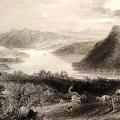 The first trade in the Eastern Townships was the making of potash. It was found that North American ashes contained a larger percentage of pure potash than those of the Baltic region. Consequently, there was a steady demand for potash. Potash was used to clear the sand in the manufacture of glass. It was also used in certain chemical processes, such as making colours fast in printed cotton materials.
The first trade in the Eastern Townships was the making of potash. It was found that North American ashes contained a larger percentage of pure potash than those of the Baltic region. Consequently, there was a steady demand for potash. Potash was used to clear the sand in the manufacture of glass. It was also used in certain chemical processes, such as making colours fast in printed cotton materials.
Potash was usually shipped from the Townships to Montreal in large barrels holding 500 pounds and valued at between $80 and $100. Cash was easier to obtain for potash than for wheat. In many settlements, representatives of potasheries would come around and buy ashes which the farmers had saved up.
Settlers had a natural opportunity to make considerable money while they went about clearing their land for farming. Clearing land presented them with major problems, because it was difficult to get rid of stumps and roots. One of the most effective ways to remove them was by burning. The ashes were then carefully collected, and placed in a sieve over a trough or tub. Hot water was then run through the ashes to drip down to the trough. This process was repeated until the water was strong enough to be lye, which was then boiled down until there was a residue of brownish ash. This substance was "potash" or black salts. It was the one item that farmers knew they could barter for needed items or even sell for cash.
When potash was put into an oven and continuously stirred, it would eventually become "pearlash." Pearlash was worth far more than potash. It was used in the manufacture of pottery, china, and soap. Making potash and pearlash was time-consuming, and demanded constant attention. Both products had to be handled carefully and packed in wooden barrels for transportation.
In the 1820s and 1830s, the ash trade was one of the most important trades in Canada, and worth a great deal of money. Getting ashes to market in Montreal, however, was a major undertaking because roads were poor, there were no bridges, and major rivers had to be crossed. C.M Day, author of History of the Eastern Townships (1869) gives us an account of the arduous process faced by two settlers from South Stukely who had each accumulated two barrels of potash:
They decided to take these barrels to Montreal and sell them. They loaded the barrels onto sleds which were drawn by yoke of oxen and started on their journey. The first obstacle they reached was the Yamaska River at Granby, where they had to leave their sleds and load the barrels onto the ferry and travel six miles downstream. They disembarked and hired carters to take them through to Chambly where they crossed the Richelieu River. The carters loaded their horses and sleds on scows, which were large flat boats formed of planks. Teams could thus be ferried across without unharnessing the animals.
From Longueuil, the settlers and their cargo switched to "batteaux" to cross the St. Lawrence River to Montreal. Batteaux were required on the St. Lawrence as the greater depth of that river and the strength of the current required differently constructed boats. The batteaux were twenty-five to thirty feet in length by seven to eight feet at the centre. Both the scow and the batteau were managed by oars and setting poles. At the wharf in Montreal, the freight was taken by carters to the inspection office and after examination it was ready for sale.
Notwithstanding the labour and expense of their journey, the two settlers from South Stukely were still able to realize a considerable profit, each receiving $100 for his load. Household necessities were taken back on the return trip. After an eighteen day journey and an expense of $20 each, the travellers finally reached home. Although $100 does not seem like much, prices back then were far lower than they are today. A pound of butter, for example, cost 28 cents.